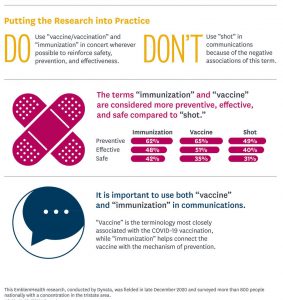As the COVID-19 vaccine rollout continues across the country, the words that communicators use might influence public willingness to be vaccinated, a new study from nonprofit insurer EmblemHealth has found.
In surveys, consumers generally understood that “vaccination” is a process intended to produce immunity to a disease or virus, whereas “immunizations” provide that protection, in both cases through the formation of antibodies. In medical contexts, EmblemHealth found, the public generally understands “shot” as a mechanism for administering vaccinations, but the word can have negative associations.
Here, Kimberly Lauersdorf, vice president of marketing for EmblemHealth, further discusses the findings and offers advice for PR professionals who may be communicating with key publics during the vaccination effort.
Based on your company’s research, what are some communications best practices related to COVID-19 vaccines?
We looked at terms like “vaccination,” “immunization,” “vaccine,” “shot,” “inoculation” and “immunity.” Consumers are pretty clear on the definitions of these words and understand that one is an administrative device, the shot or the vaccine. Another is the process of being immunized, the immunization, the vaccination, the inoculation.
If you look at how we speak as health-care companies, whether a provider or an insurance group, a Walgreens or CVS, we all use this language interchangeably. We may be talking about a vaccination and then in the same breath say “immunization.”
The terms “vaccines” and “immunizations” need to be used together. It can be as simple as a sentence: “Get your COVID vaccine to immunize you against the coronavirus.”
“Vaccine” or “vaccination” and “immunization” have different appeal in different audiences. So Black and white populations slightly prefer the use of “immunization,” while Latinx and Asian populations slightly prefer “vaccine.” Using both terms, “vaccination” and “immunization,” will] broaden your message and make sure that you’re not leaving anyone on the sidelines.
Another best practice is to eliminate the word “shot” from our vocabulary as health-care professionals.
“Flu shot” is part of our seasonal vernacular, so why is the term “shot” a challenge in the context of the COVID-19 vaccine? And what word do you recommend instead?
We hear “flu shot” every year — it’s a very common. We looked at all types of vaccinations, not just for COVID. Everything from childhood immunizations to shingles and pneumonia vaccines regardless of who you are demographically. Everyone reacted to “shot” as something risky, scary and unsafe. From a clinical perspective, “shot” evokes needles, injection and pain.
To get people to protect themselves and their communities, as communicators scrubbing the word “shot” will get us closer to our objectives and to making sure that people get vaccinated.

What are the particular challenges for vaccine communications in Black communities?
We have to understand and acknowledge that the health-care system has not always had their best interests in mind, that historical clinical trials could be seen as scientific abuse. As communicators, we have to acknowledge the vaccine hesitancy and treat that conversation with the respect it’s due to help our Black communities. Then we can start talking about the language.
Eliminating the word “shot” is a big part of it. Referencing the COVID vaccine but pivoting that into immunization — that’s going to be key for our Black populations.
The third step after we’ve acknowledged the reality and landed on the language becomes how we are getting the message out. We did a study at the EmblemHealth family of companies in the fall, ahead of the flu season, to make sure that we could increase adoption, especially during a possible twin pandemic.
We found the importance of the channels that you use. Across Black populations, as well as other populations, the primary-care physician is a trusted source.
In another study last spring, we found that the Black community was more likely than the general population to have access to only one technology device in their home. And that almost one-third of the Black community reported having inadequate internet access.
One of the things that we did around flu vaccinations [was to pair] them with food events in local communities. We gave away meals and we had a flu vaccine right there. This brought the awareness, the communication directly into the population.
We have to think about the context of our conversation, the language we’re using and the channels we’re using to get it out.
Why are people more susceptible to misinformation about the COVID-19 vaccine, compared to other vaccines in the past?
I’m not sure that as consumers we’re more susceptible to misinformation for the COVID vaccine versus other vaccines.
We did a study in the fall around the flu vaccine. The top four reasons why people told us they weren’t going to get the flu vaccine might sound familiar, if we think about what we’re hearing around COVID vaccination: “I’m concerned about the side effects. I don’t believe it’s effective. I’m not in a high-risk group. I don’t think the flu vaccination is safe.”
This is what people were telling us about the flu vaccine that has been around for decades and has the science behind it. And that’s immediately what people are telling us about the COVID vaccination. I think what’s different around misinformation [this time] is the scale, the noise, the volume.
How often do people think about the flu vaccine in a given year, compared to the times they have thought about the COVID vaccine in the last year? As communicators, we have an opportunity: Should the topic that we want to be talking about always be the front-page news story, every single day?
How do we continue to be consistent in the language that we’re using, consistent in the narratives that we’re telling, consistent in the voices? The simplicity of pairing “vaccine” with “immunization,” eliminating the word “shots” — that consistency is one of our greatest weapons against misinformation as communicators.
How can consumers know whether the information they find about the COVID-19 vaccine is credible?
Our research found that the primary-care provider is the most trusted source of information for consumers when it comes to vaccinations. As communicators, we need to be using the trusted sources, the voices of doctors.
Whether I’m a health plan or a provider group or another piece in this health-care puzzle, we should be encouraging people to have conversations with their doctors. This is your health and they’re there to help you. We have to make sure that people feel comfortable with this conversation.
John Elsasser is the publications director of PRSA. He joined PRSA in 1994.
[Photo credit: shutterstock]








Words matter! Great advice, as many of these terms conjure fear and misunderstanding and are counterproductive if we want people to take the vaccine.
This is such an interesting topic to cover. In the PR world, carefully crafting messages is one of the most important factors to success. The COVID-19 pandemic has taught us many lessons about framing vaccine efforts in a positive light to encourage citizens to get vaccinated. I agree with your statement about message channels being crucial to message delivery. We as practitioners must consider the needs of our audience and adjust our message delivery accordingly.
I am always so blown away when reading about the many ways PR professionals play such a big part in our decision making. I love the fact that different backgrounds and ethnicities were considered when deciding on wording and format of proving the vaccine to the public. It is pretty common knowledge in the PR world that wording means everything, but it is also very important to know who you are talking to when considering wording. This blog tuly covers all the bases on what we need to know about PR writing and the COVID-19 vaccine.
I agree with this article. As I learned in my introductory PR class, getting people to take the COVID-19 vaccine will be one of the biggest PR challenges of our time. The public’s opinion is very split. Many people aren’t really sure what to think of it. So the better job public relations practitioners do, the faster the COVID-19 pandemic will be over. I really liked how you recommended removing certain words that have a negative connotation. Many people, including myself, have a fear of shots. When people hear the word shot, they will automatically think about the vaccine in a negative way. Many people think of shots as scary and unsafe. Using other words like immunizations will put a better idea in people’s minds when thinking about the vaccine.
This blog is an interesting look at the importance of using strategic language and appropriate channels when conveying important messages to the public. I never considered the negative connotation of the word “shot” when talking about COVID-19 vaccinations, but it does indeed carry an association with pain and needles. As you said, vaccinations are a much more neutral term, especially coming from trusted sources like healthcare professionals.
Overall, PR professionals need to be aware of their power over the public’s perception and practice using proper language in their messaging.
I strongly agree with this blog post. I feel as though different words carry different connotations and ‘weight,’ and I feel as though comparing vaccine to shot is a perfect example. I haven’t actively thought about the differing effects of the two words until this blog post, but the research results hold true for me personally. I definitely have always equated the word shot to be more negative than vaccine, therefore it makes sense that healthcare professionals and pharmaceutical advertisements tend to stay away from the word “shot.” I found it very interesting that ethnic origin also played a role in what term individuals preferred hearing.
I will say however, I do not necessarily agree with your argument that we as consumers are not more susceptible to misinformation with COVID-19 vaccines than other virus vaccines. I think your supporting facts and viewpoints are credible, but I feel as though you’re failing to look at the argument from the proper angle. I feel as though consumers are more susceptible to misinformation in regards to the COVID-19 vaccine because of the differing reports made by the media (regarding levels of infection, vaccine effects, death toll, etc.). Besides this viewpoint, I agree with the entirety of the article and your arguments.
Kayla Peace
WESTERN KENTUCKY UNIVERSITY